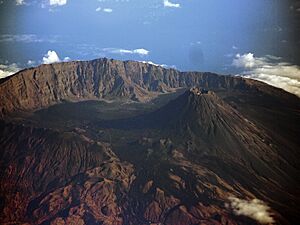Pico do Fogo facts for kids
Quick facts for kids Pico do Fogo |
|
|---|---|

View of the peak.
|
|
| Highest point | |
| Elevation | 2,829 m (9,281 ft) |
| Prominence | 2,829 m (9,281 ft) |
| Listing | Country high point |
| Geography | |
| Location | Fogo, Cape Verde |
| Geology | |
| Mountain type | Stratovolcano |
| Last eruption | 1995 |
Pico do Fogo means "Fire Peak" in Portuguese. It is the tallest mountain in Cape Verde, standing at 2,829 meters (9,281 feet) above sea level. This mountain is an active stratovolcano, which is a tall, cone-shaped volcano. It is located on the island of Fogo.
The main part of the volcano last erupted a long time ago, in 1675. During that eruption, everyone living on the island had to leave for safety. More recently, in 1995, lava flowed from a side opening of the volcano. The most dangerous eruption happened in 1847. Earthquakes shook the whole island and caused many deaths. In the past, lava from Pico do Fogo has even reached the eastern coast of the island.
Contents
What is Pico do Fogo?
Pico do Fogo is a stratovolcano. This type of volcano is built up over time by many layers of hardened lava, ash, and rocks. They often have a steep, cone-like shape. Pico do Fogo is the highest point in all of Cape Verde.
The Giant Crater
One of the most amazing parts of Pico do Fogo is its huge volcanic crater. This crater is also called a caldera, or caldeira in Portuguese. It is about 9 kilometers (5.6 miles) wide. The edge of this crater, called a bordeira, is about 1 kilometer (0.6 miles) high.
The crater has an opening on its eastern side. In the middle of this large crater, there is a tall peak. This central peak is the highest point of the island, reaching 2,829 meters. It stands about 100 meters (328 feet) taller than the bordeira that surrounds the crater.

Life Around the Volcano
The lowest part of the caldeira floor is known as Chã das Caldeiras. This area is about 1,625 meters (5,331 feet) high. There are two villages inside the caldeira. People living in these villages had to leave during the last eruption.
For a long time, people have grown grapes on the inner slopes of the bordeira. Some farming for food also takes place on the caldeira floor. The slopes of the mountain are also used to grow coffee. The hardened lava from the volcano is even used as a building material.
Animals and Plants
Pico do Fogo is home to special wildlife. The Fea's petrel (Pterodroma feae) is a type of bird that nests on this mountain. This bird species is considered "Near Threatened," meaning it could become endangered.
Two unique plants, Echium vulcanorum and Erysimum caboverdeanum, grow only on the outer edge of the volcano. These plants are called endemic because they are found nowhere else in the world.
Images for kids
See also
 In Spanish: Pico do Fogo para niños
In Spanish: Pico do Fogo para niños





